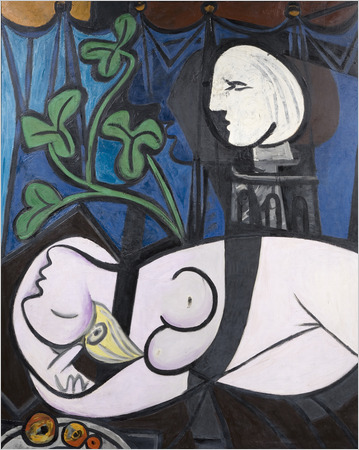A painting should reflect how the artist perceives the subject, and you appreciate it for the effect it has on you, the viewer. During my younger days, I did not have many definite ideas about art and artists, for the simple reason that I did not know enough, though I did appreciate art. Looking at Rodin’s Thinker was an experience that touched the soul; the impressionists left an impact of a painting that far transcended realism. The fundamentals of art are universal, and people are ready to pay maximum dollars to possess paintings by masters.

Pablo Picasso’s 1932 painting, Nu au Plateau de Sculpteur
(Nude, Green Leaves and Bust).
From Website
A painting by Pablo Picasso has just been sold in New York for $106.5 million — a new world record. The 1932 painting, Nu au Plateau de Sculpteur (Nude, Green Leaves and Bust), has Marie-Therese Walter, the artist’s mistress, in a reclining position and also in a bust. Picasso included his own profile in the blue background.
Picasso was a painter about whom I had strong views. When I was young, Picasso’s work left me totally unmoved and impressed, though, to be fair, I had graduated from an earlier stage when I felt that Picasso was a bit like me, someone who couldn’t paint and thus odd shapes like triangles for the nose!
I lived in ignorance for decades. I remained somewhat suspicious of the person whose full name was Pablo Diego José Francisco de Paula Juan Nepomuceno María de los Remedios Cipriano de la Santísima Trinidad Ruiz y Picasso.
Although he dominated the 20th-century art scene, he left me unmoved. By the end of the century, I had seen the world, but not Picasso’s place in the world of art. It was the dawn of the 21st century that enabled me to finally shed this bit of ignorance, and my prejudice towards Picasso. The trigger was a colleague who had just visited an exhibition of the works of the great artist mounted at the National Museum, New Delhi. The Government of France had sponsored the “Picasso: Metamorphoses, 1900-1972, From the French Collections, from December 2001 to February 2002”.
Gaurav had seen the exhibition and was bubbling with enthusiasm, talking constantly about it to my colleagues and me. His account of how great the exhibition was, and how it aided his understanding of the artist enthused me enough to drive down to Delhi one Sunday morning, straight to the museum.
Having started early, I found myself there by the opening time and went in. Here were 122 works – graphics, drawings, collages, assemblages and sculpture. What an array divided into various sections that profiled the panoramic sweep of Picasso’s prolific career. Blue Period paintings, early turn-of-century, brooding contemplative works, the brilliant sculptures, his portraits, which were thoughtfully placed along with photographs of the subjects… Picasso’s greatness finally sunk into.
I realised, not for the first or the last time, what a fool I had been, in not getting rid of the negativity of ill-formed opinions based on prejudice. Thank God, providence and prodding had enabled me to discover the greatness of an artist.
I went out for lunch and came back to the museum. I bought some prints and generally spent as much as I could afford before driving back to Chandigarh that evening. I had thought of meeting friends, as I always do when I am in Delhi, but that didn’t happen. I needed to be alone to absorb what I had experienced during the day.
This middle, by Roopinder Singh, was published in The Tribune on May 6, 2010



